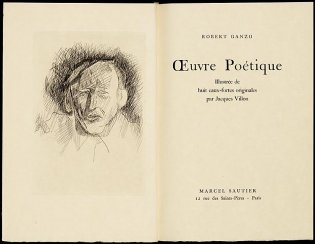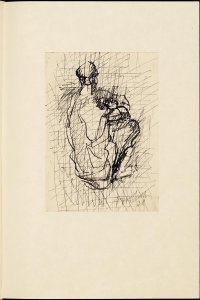Oeuvre poétique
Year: 1957
Author: Robert Ganzo (1898 - 1995)
Artist: Jacques Villon (1875 - 1963)
Publisher: Sautier
The golden section
In 1912, Jacques founded the 'groupe de la Section d'Or' together with artists he knew (Francis Picabia, Fernand Léger and his brothers Marcel Duchamp and Raymon Duchamp-Villon. The group was named after the theory of proportions demonstrated by Leonardo da Vinci, which was based on the golden section. Villon would later continue to apply the golden section in his Cubist work. That made his work systematic, orderly and harmonious, as opposed to the more expressive Cubism of Picasso, for instance.
For Oeuvre poétique, Villon produced eight etchings, two of which are in colour. The variation in the etchings makes the work both aesthetically and technically accomplished: not only are there colour etchings and etchings with aquatint, but there are also various presentations: a portrait of the poet, sketches of female nudes, and abstract compositions. The copy in the Koopman Collection is a deluxe edition: both the texts and the etchings are printed on Japanese paper.
Mercher
The binding was produced by Mercher. Bookbinder Henri Mercher (1912-1976) was a student of Robert Bonfils (one of the first members of the Société de la Reliure Originale) at the École Estienne. Mercher himself used to say that he was one of the worst students. He worked from 1935 onwards, and after World War II, he also occupied himself with the design of bindings. He became famous first and foremost due to his choice for unorthodox materials such as Plexiglas. But his leather bindings also became well-known, mostly on account of his strong eye for detail. This copy has all edges gilt and the inner deckles of the upper and lower board have been covered with blue and purple suede. The leather binding is a composition of black circles and lines with round planes of colour within them: yellow, blue, brown, grey, and green. The binding bears a protective cover and a slipcase.
Bibliographical description
Description: Oeuvre poétique / Robert Ganzo ; ill. de huit eaux-fortes orig. par Jacques Villon. - Paris : Sautier, 1957. - [129] p. : ill. ; 29 cm Drukker Jean Paul Vibert (tekst) Georges Leblanc (etsen)
Edition: 185 copies
This copy: 8 of 10 on Imperial Japanese paper
Typeface: Caslon
Bookbinder: Henri Mercher (1960)
Note: With an original drawing, a copperplate, an extra set of illustrations in the first state and an extra set printed in red-brown, Signed by the author and the artist
Bibliography: Bénézit 14-254 ; Monod-5115 ; Prout II-57-04
Shelfmark: KW Koopm K 316
References
- Pierre Cabanne, Les 3 Duchamp: Jacques Villon, Raymond Duchamp-Villon, Marcel Duchamp. Neuchâtel, Ides et Calendes, 1975
- Paul van Capelleveen, Sophie Ham, Jordy Joubij, Voices and visions. The Koopman Collection and the Art of the French Book. The Hague, Koninklijke Bibliotheek, National Library of the Netherlands; Zwolle, Waanders, 2009
- Paul van Capelleveen, Sophie Ham, Jordy Joubij, Voix et visions. La Collection Koopman et l'Art du Livre français. La Haye, Koninklijke Bibliotheek, Bibliothèque nationale des Pays-Bas; Zwolle, Waanders, 2009
- J. Flety, Dictionnaire des relieurs français ayant exercé de 1800 a nos jours, suivi d'un guide pratique des relieurs, doreurs, marbreurs et restaurateurs contemporains. Paris, Éditions Technorama, 1988
- Irene M. de Groot, Jacques Villon: Grafiekuit een particuliere verzameling. Amsterdam, Rijksmuseum, 1984
- Jacques Villon Paris, Éditions des musées nationaux, 1975
- W.J. Strachan, The artist and the book in France: The 20th century livre d'artiste. London,Owen, 1969



![Kleurenets door Jacques Villon (p. [75])](/sites/default/files/styles/galerie/public/images/oeuvre-poetique-p75.jpg?h=396c6921&itok=g1ORGN43)

